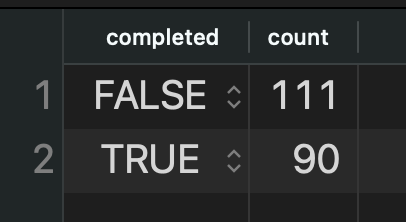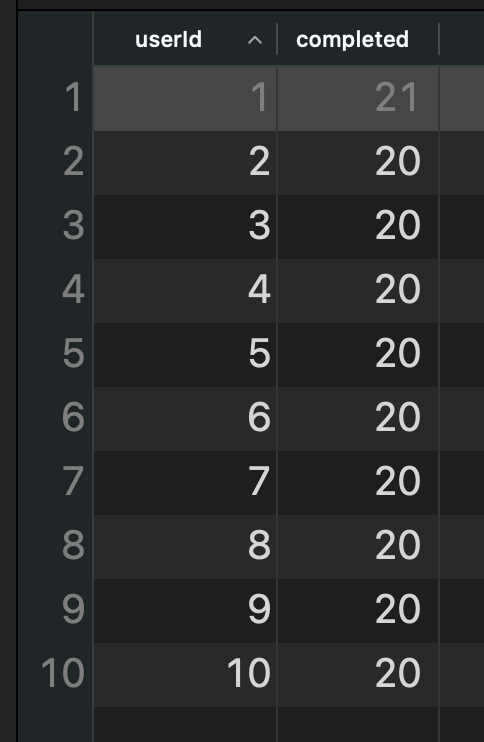大家好!
雙十節前除了準備早起參加升旗外,還要做些什麼呢?
...
練習和研究自己無法想像的aggregate functions 如何?
![]()
那讓我們開始吧!
什麼情形要用到aggregate function 呢?
以todos 這table 為例:
create_table "todos", force: :cascade do |t|
t.integer "userId"
t.text "title"
t.boolean "completed"
t.datetime "created_at", precision: 6, null: false
t.datetime "updated_at", precision: 6, null: false
end
我們可以很直覺地統計「completed 為true 或false 的筆數」、「各user 有幾筆todos」、或進一步計算出「各個user 各自completed 的todos 完成率」、「所有user completed 的todos 平均值」等,在我們練習之前,先來了解aggregate function 是什麼:
Aggregate functions compute a single result from a set of input values.
翻譯蒟蒻:聚合函數是根據一組輸入值計算並返回單一值
The built-in normal aggregate functions are listed in Table 9-49 and Table 9-50. The built-in ordered-set aggregate functions are listed in Table 9-51 and Table 9-52. Grouping operations, which are closely related to aggregate functions, are listed in Table 9-53. The special syntax considerations for aggregate functions are explained in Section 4.2.7. Consult Section 2.7 for additional introductory information.
以PostgreSQL 來說,aggregate functions 分成四個種類,內建的普通函數,如表9-49(count, max, min, sum, avg, array_agg)、9-50 的標準差、9-51、52 有序集合函數等(後略)
而aggregate function 的基本用法如:
SELECT count(*) FROM sometable;
讓我們先來試試用聚合函數完成以上假想的情境吧!
情境1:completed 為true 或false 的筆數
SELECT completed, count(completed) FROM todos GROUP BY completed

情境2:各user 有幾筆todos
SELECT "userId", count(completed) AS completed FROM todos GROUP BY "userId"

那我們又能否利用Active Record 裡的方法,但不用SQL 而得到同樣的結果呢?我們來試試看~~
情境1:completed 為true 或false 的筆數
# 這題之前就做過了,簡單~~
irb(main):003:0> Todo.group(:completed).count
(0.8ms) SELECT COUNT(*) AS count_all, "todos"."completed" AS todos_completed FROM "todos" GROUP BY "todos"."completed"
{
false => 111,
true => 90
}
情境2:各user 有幾筆todos
irb(main):005:0> Todo.select(:userId, :completed).group(:userId, :completed).order(:userId).size
(1.0ms) SELECT COUNT(*) AS count_all, "todos"."userId" AS todos_userid, "todos"."completed" AS todos_completed FROM "todos" GROUP BY "todos"."userId", "todos"."completed" ORDER BY "todos"."userId" ASC
{
[ 1, true ] => 11,
[ 1, false ] => 10,
[ 2, false ] => 12,
[ 2, true ] => 8,
[ 3, false ] => 13,
[ 3, true ] => 7,
[ 4, false ] => 14,
[ 4, true ] => 6,
[ 5, false ] => 8,
[ 5, true ] => 12,
[ 6, false ] => 14,
[ 6, true ] => 6,
[ 7, false ] => 11,
[ 7, true ] => 9,
[ 8, false ] => 9,
[ 8, true ] => 11,
[ 9, false ] => 12,
[ 9, true ] => 8,
[ 10, true ] => 12,
[ 10, false ] => 8
}
那麼再進一步的情境3、4 又是否能寫出來呢?(對我現在好難,容被翻爛的書再想想 XD)
情境3:所有user completed 的todos 平均值
情境4:各個user 各自completed 的todos 完成率
![]()
可練習至此令我不禁好奇,aggregate function 回傳的單一結果又代表了什麼?
目前覺得GeeksforGeeks 的解釋還滿不錯的:
In database management an aggregate function is a function where the values of multiple rows are grouped together as input on certain criteria
to form a single value of more significant meaning.
我想正如同上述的假設情境,若我們列出200 筆todos 時的資料雖然很清楚但卻不具有可讀性,而當我們用進一步利用aggregate functions 來整理時,這些資料才逐漸有了意義
最後在結束前想再比較SQL 和Active Record query 的statement 有何差異:
情境1:completed 為true 或false 的筆數
# By raw SQL
SELECT completed, count(completed) FROM todos GROUP BY completed
# By Active Record
SELECT COUNT(*) AS count_all, "todos"."completed" AS todos_completed FROM "todos" GROUP BY "todos"."completed"
這句的差異應該是SELECT 後的語句:SELECT completed, count(completed) vs. SELECT COUNT(*) , "todos"."completed",raw SQL 直接針對completed 欄位計算,Active Record 則是計算了每個row?
情境2:各user 有幾筆todos
# By raw SQL
SELECT "userId", count(completed) AS completed FROM todos GROUP BY "userId"
# By Active Record
SELECT COUNT(*) AS count_all, "todos"."userId" AS todos_userid, "todos"."completed" AS todos_completed FROM "todos" GROUP BY "todos"."userId", "todos"."completed" ORDER BY "todos"."userId" ASC
這邊可能是自己的Ruby 寫太差啦,一定有更好的寫法;除了SELECT 後的語句 一樣多了一個count(*)外,GROUP BY 似乎也多了"todos"."completed",但若不用就會噴錯,Hmm...?
總之今天的練習就先到這囉,謝謝大家!
